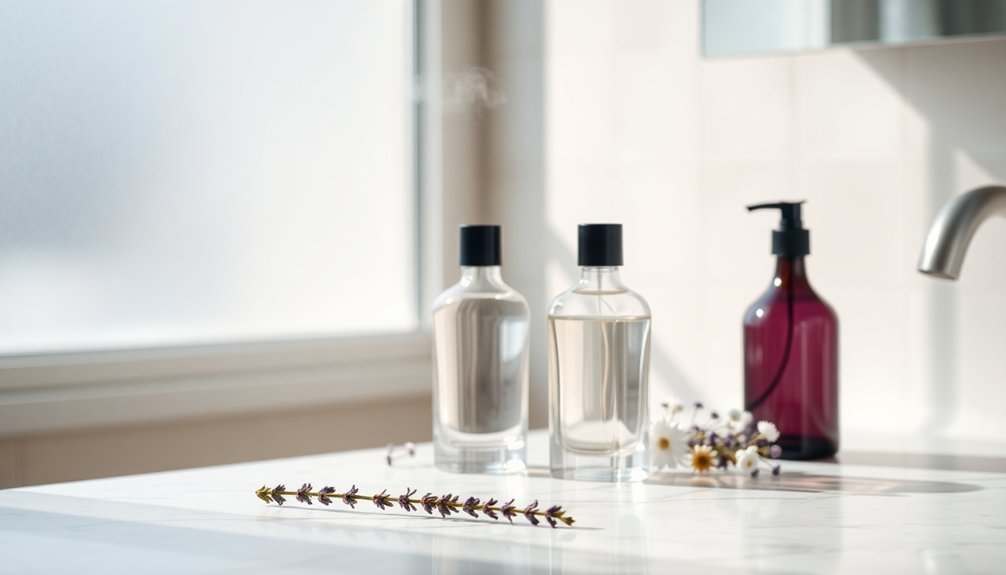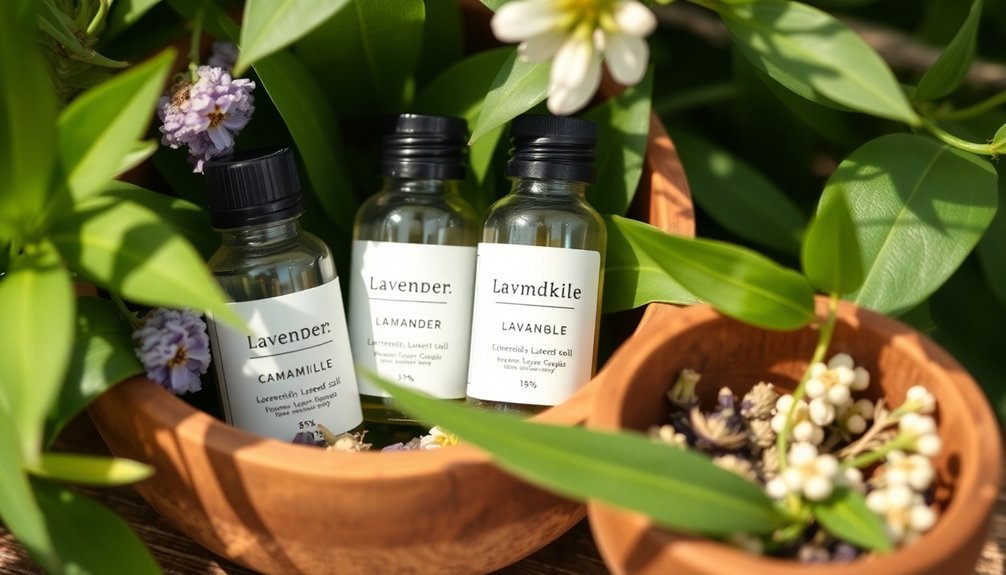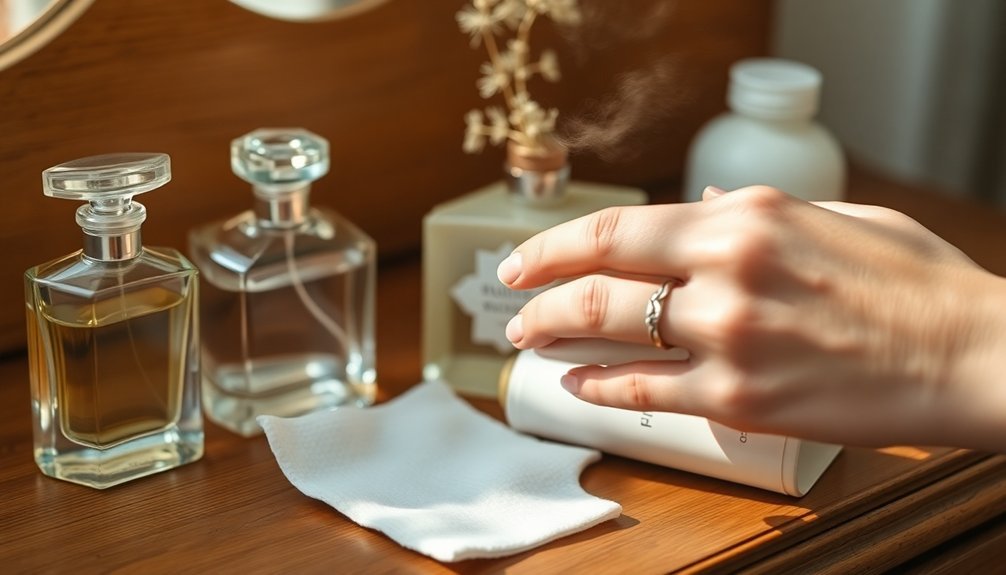If you have sensitive skin, you'll want to choose hypoallergenic perfumes that contain natural essential oils like lavender, chamomile, and sandalwood. Avoid synthetic fragrances, which trigger reactions in nearly 30% of people. Always patch test new scents on your inner wrist for 24-48 hours before regular use. Apply to moisturized skin using a gentle dabbing technique at pulse points. Understanding your skin's specific triggers will help you find your perfect signature scent.
Understanding Skin Sensitivity and Fragrance Reactions

While many people enjoy wearing perfume as part of their daily routine, those with sensitive skin must navigate fragrance choices more carefully.
With nearly 30% of the population experiencing fragrance sensitivity, it's essential to understand how your skin might react to various ingredients.
Your sensitive skin may become irritated by synthetic additives, alcohol, and preservatives commonly found in perfumes. Common allergens like limonene, linalool, and synthetic musk can trigger skin reactions including redness and itching.
Before choosing hypoallergenic perfumes, you'll want to perform patch testing on your inner wrist to identify potential irritants.
Consider fragrances that incorporate natural ingredients, such as essential oils like lavender and chamomile, as they're typically better tolerated than those containing harsh chemicals.
Natural vs. Synthetic Perfume Ingredients
When choosing perfumes for sensitive skin, understanding the fundamental differences between natural and synthetic ingredients becomes essential for making informed decisions.
Natural fragrances, particularly those containing essential oils and organic ingredients, are typically gentler and less likely to irritate sensitive skin. Research shows that nearly 30% of people react negatively to synthetic fragrances, which often contain harsh chemicals like phthalates and synthetic musks.
You'll find that hypoallergenic perfumes often prioritize natural extracts over synthetic compounds, making them a safer choice for your sensitive skin.
These natural alternatives provide clearer ingredient lists, helping you identify and avoid potential irritants. By selecting perfumes with plant-based components rather than artificial fragrances, you're reducing your risk of skin irritation and allergic reactions while still enjoying your favorite scents.
Essential Oils Safe for Sensitive Skin Types

Several gentle essential oils offer a natural fragrance solution for those with sensitive skin, building on the benefits of natural ingredients discussed above.
You'll find that lavender, chamomile, and sandalwood provide calming properties while being well-tolerated by reactive skin types.
When selecting essential oils, choose organic options without synthetic additives to minimize irritation risks.
You should always dilute these oils with a carrier oil like jojoba or sweet almond oil to enhance skin compatibility.
Before applying any new essential oil, perform a patch testing on a small area to check for potential sensitivities.
For additional skin benefits, consider essential oils with anti-inflammatory properties, such as calendula and tea tree oil.
These options can soothe your skin while reducing the likelihood of adverse reactions when properly diluted and applied.
Patch Testing Methods for New Fragrances
When testing a new fragrance, you'll want to select an inconspicuous spot like your inner wrist or behind your ear as your test area.
Start by applying just a tiny drop of the product to your chosen patch of skin, making sure not to use too much at once.
Watch the test area closely for the next 48 hours, checking for any signs of redness, itching, or irritation before deciding if the fragrance is safe for regular use.
Choose Test Skin Area
Testing a new perfume requires careful attention to the application site. When you're ready to patch test a new fragrance, select an inconspicuous area of your skin that's easy to monitor. The inner wrist or behind the ear are ideal locations, as they're both discreet and sensitive enough to detect potential allergens quickly.
Apply a small amount of the fragrance to your chosen spot and watch for any allergic reactions over the next 24 to 48 hours.
You'll want to look for signs of irritation such as redness, itching, or burning. Keep track of your results, especially if you're testing multiple hypoallergenic fragrances.
It's best to test one perfume at a time to accurately identify which scents your sensitive skin can tolerate. If any discomfort occurs, stop using the fragrance immediately.
Apply Small Product Amount
Proper patch testing begins with a tiny drop of fragrance – no larger than a single raindrop. When you're dealing with sensitive skin, it's vital to apply a small amount to a discrete area and monitor for adverse reactions over the next 24 to 48 hours.
This careful approach provides an essential layer of assurance before committing to full application.
Don't apply other skincare products to the test area during this period, as they could interfere with your ability to identify potential allergens. If irritation occurs, such as redness, itching, or burning, you'll know to avoid that particular fragrance.
Monitor For 48 Hours
Once you've applied your patch test, the 48-hour monitoring period becomes vital for accurately evaluating your skin's reaction to new fragrances.
If you have sensitive skin, it's important to watch for any adverse reactions during this time.
Here's what you'll need to monitor:
- Check for visible signs of irritation like redness or swelling around the patch test area.
- Notice any uncomfortable sensations such as itching, burning, or stinging.
- Document your observations to track personal sensitivities for future reference.
- Watch for delayed reactions that might appear after the first 24 hours.
If you experience any negative reactions, immediately wash the area and apply a fragrance-free moisturizer to soothe your skin.
If no irritation occurs after 48 hours, you can likely use the fragrance safely, but still start with minimal amounts.
Hypoallergenic Perfume Formulation Guidelines
When selecting ingredients for hypoallergenic perfumes, you'll want to focus on natural essential oils and plant extracts while avoiding common irritants like synthetic preservatives and artificial dyes.
You should always verify that each ingredient has passed dermatologist testing and meets strict hypoallergenic standards before inclusion in your formulation.
Before introducing any new fragrance to your skin, perform a 24-hour patch test on a small area of your inner arm to check for potential reactions.
Common Allergen-Free Ingredients
Selecting allergen-free ingredients forms the foundation of hypoallergenic perfume formulation. When you're choosing a perfume for sensitive skin, look for products that prioritize natural extracts and essential oils while avoiding synthetic additives.
Common allergen-free ingredients in these formulations offer both fragrance and skin benefits.
Key components you'll find in safe hypoallergenic perfumes include:
- Essential oils like lavender, chamomile, and sandalwood that provide gentle fragrance without irritation
- Natural extracts such as aloe vera and shea butter that offer moisturizing benefits
- Alcohol-free options that prevent skin dryness and discomfort
- Transparent ingredient lists that help you identify potential allergens
These carefully selected components guarantee you can enjoy beautiful fragrances without compromising your skin's health or risking allergic reactions.
Patch Testing Safety Protocols
Before incorporating any new fragrance into your skincare routine, proper patch testing serves as your first line of defense against potential allergic reactions. Apply a small amount of the perfume to your inner wrist or behind your ear, then monitor the area for 24 to 48 hours to check for adverse reactions.
When selecting fragrances, opt for hypoallergenic perfumes that are specifically designed for skin sensitivity. Look for dermatologist-tested or allergy-tested labels, as these products undergo rigorous testing to ascertain safety.
Don't apply perfume to broken or irritated skin, as this can increase your risk of discomfort. If you notice any irritation during patch testing, stop using the product immediately.
Take note of the ingredients to identify potential allergens, helping you make informed choices about future fragrance purchases.
Carrier Oils and Dilution Ratios

For those with sensitive skin, proper dilution of perfume oils is essential to prevent irritation and adverse reactions. Carrier oils help make essential oils safe for sensitive skin by reducing their concentration while adding moisturizing properties.
You'll find that common carrier oils like jojoba, sweet almond, and coconut oil work effectively as natural diluting agents.
When mixing your perfume oils, follow these dilution ratios for ideal safety:
- Start with a 0.5% dilution (1 drop per teaspoon of carrier oil)
- Never exceed 2 drops of essential oil per teaspoon
- Choose carrier oils known for skin compatibility
- Test your diluted mixture on a small patch first
These guidelines will help you create perfume blends that are gentle enough for your sensitive skin while minimizing the risk of allergic reactions or irritation.
Recommended Storage and Shelf Life
When storing perfumes formulated for sensitive skin, proper storage conditions play an essential role in maintaining their safety and effectiveness.
You'll want to store them properly in a cool, dark place away from direct sunlight to preserve their gentle formulation.
Most perfumes have a 3-5 year shelf life, but those with natural ingredients typically last only 1-2 years.
To prevent evaporation and maintain quality, keep bottles tightly sealed when not in use.
Avoid storing your perfumes in the bathroom, where humidity and temperature fluctuations can compromise their integrity. Instead, choose a stable environment like a bedroom drawer.
Regularly check the scent's characteristics for any significant changes in color or aroma.
If you notice alterations, it's time to replace your perfume to guarantee it remains safe for your sensitive skin.
Application Techniques for Minimal Irritation

The proper application technique can make all the difference in how your sensitive skin responds to perfume. By following specific application techniques, you'll minimize irritation while still enjoying your favorite scents.
Using a dabbing technique instead of rubbing helps prevent friction that can irritate sensitive skin.
To protect your skin while wearing perfume:
- Apply a fragrance-free moisturizer first to create a protective barrier
- Target pulse points behind your ears and on wrists for ideal scent diffusion
- Dab the perfume gently rather than rubbing it into your skin
- Monitor skin reactions for any potential sensitivities within the first hour
Remember to store your perfumes properly in cool, dry places to maintain their integrity and prevent chemical changes that could trigger unwanted skin reactions.
Identifying Common Fragrance Allergens
Your perfume's ingredient list may contain both synthetic compounds like phthalates and natural allergens like limonene, which can trigger skin reactions even in natural fragrances.
To uncover your specific sensitivities, perform a patch test by applying a small amount of the fragrance to your inner arm and monitoring for 48 hours.
If you experience redness, itching, or bumps, you'll know which ingredients to avoid in future fragrance purchases.
Hidden Synthetic Chemical Compounds
Understanding hidden synthetic compounds in perfumes can protect you from unexpected skin reactions. When selecting fragrance for sensitive skin, you'll need to be vigilant about undisclosed ingredients that could irritate your skin.
To identify potentially harmful synthetic compounds, watch for these common culprits:
- Phthalates, which manufacturers often use to make fragrances last longer but can trigger allergic reactions.
- Synthetic musks that commonly cause skin irritation and may worsen asthma symptoms.
- Oxidized compounds like limonene and linalool, which become more likely to cause reactions over time.
- Alcohol-based ingredients that can dry out and irritate delicate skin.
For safe fragrance choices, look for products with complete ingredient transparency. Many brands don't disclose their full synthetic compound list, making it essential to research thoroughly before purchasing.
Natural Vs Artificial Allergens
While many assume natural fragrances are inherently safer than synthetic ones, both types can trigger allergic reactions in sensitive individuals.
Natural perfumes, especially those containing essential oils like lavender and chamomile, can irritate the skin just as readily as synthetic fragrances.
You'll find that synthetic fragrances often contain hundreds of chemical compounds, making it challenging to identify specific fragrance allergens causing your reaction.
In contrast, natural perfumes typically have fewer ingredients, which can make it easier to pinpoint what's triggering your sensitivity.
Whether you're considering natural or artificial options, it's essential to perform patch testing before using any new fragrance.
This simple step helps you determine if your sensitive skin will react negatively to specific ingredients, allowing you to make informed choices about your perfume selection.
Patch Testing Best Practices
Before introducing any new fragrance to your skincare routine, performing a thorough patch test can prevent uncomfortable allergic reactions and help identify specific irritants. Common fragrance allergens like limonene, linalool, and synthetic musk can trigger skin responses, making patch testing essential for sensitive skin.
Follow these steps for effective patch testing:
- Apply a small amount of fragrance to your inner wrist or behind your ear.
- Monitor for any adverse reactions over 24-48 hours, keeping detailed notes of skin responses.
- Check that your chosen fragrance is free from harsh ingredients like parabens, phthalates, and alcohol.
- If you experience irritation and discomfort, discontinue use immediately.
Remember to consult a dermatologist if you notice any concerning reactions during testing. They'll provide personalized guidance for choosing suitable fragrances that won't irritate your sensitive skin.
Building a Custom Perfume Blend
Creating your own perfume blend offers a safe and personalized solution for those with sensitive skin. Start by selecting hypoallergenic essential oils like lavender or chamomile, known for their gentle properties. Dilute these oils with natural carrier oils such as jojoba or fractionated coconut oil to minimize irritation risks.
| Essential Oil | Benefits for Sensitive Skin |
|---|---|
| Lavender | Soothing, calming effects |
| Chamomile | Anti-inflammatory properties |
| Green Tea | Light, fresh scent profile |
| Citrus | Natural, well-tolerated fragrance |
Before applying your custom blend widely, conduct patch tests on a small skin area. You'll want to avoid synthetic ingredients like phthalates and parabens, which can trigger reactions. Instead, focus on creating a pleasant scent using light, natural fragrances that'll work harmoniously with your sensitive skin while providing the desired aromatic experience.
Monitoring and Managing Skin Reactions

When testing new perfumes on sensitive skin, proper monitoring becomes your first line of defense against adverse reactions.
To effectively monitor skin reactions and identify potential irritants, you'll want to follow these essential steps:
- Perform patch tests on discreet areas like your inner wrist or behind your ear, waiting 24-48 hours to observe any reactions.
- Track perfumes and skin reactions in a dedicated journal, helping you identify specific ingredients that cause irritation.
- Practice gradual exposure with new scents, since reactions can develop immediately or over time.
- Adjust your application techniques by spraying fragrance on clothing instead of skin to minimize direct contact.
If you experience persistent irritation, don't hesitate to consult a dermatologist.
They'll help pinpoint allergens and recommend fragrances suitable for your sensitive skin.
Frequently Asked Questions
Can I Wear Perfume if I Have Sensitive Skin?
Yes, you can wear perfume with sensitive skin. Choose hypoallergenic, alcohol-free options with natural ingredients. Do a patch test first, and stick to light, delicate scents to avoid irritation and discomfort.
What Can I Wear if I'm Allergic to Perfume?
You can try hypoallergenic or natural fragrance oils, which are gentler on sensitive skin. Look for alcohol-free options and do a patch test first. Fragrance-free products are also safe alternatives for daily use.
What Is a Hypoallergenic Perfume?
A hypoallergenic perfume is specially made for you if you've got sensitive skin. It's formulated with fewer allergens and irritants, using natural ingredients instead of harsh chemicals, making it less likely to cause reactions.
How to Smell Good With Sensitive Skin?
You'll smell great by using hypoallergenic fragrances, applying unscented moisturizer first, and choosing alcohol-free options. Always patch test new scents and opt for lighter concentrations like body mists or Eau de Toilette.
In Summary
You don't have to give up wearing fragrances just because you have sensitive skin. Start with patch testing, opt for hypoallergenic formulas, and consider natural essential oils that work well with your skin type. By following proper application techniques and learning to identify problematic ingredients, you'll be able to safely enjoy your favorite scents while keeping your sensitive skin happy and irritation-free.





Leave a Reply